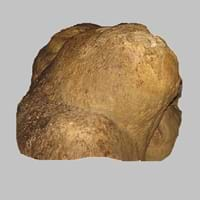Definition
Travertine is a mineral consisting of layered calcium carbonate formed by deposition from spring waters
Lignite is a soft brownish coal which shows traces of plants and is intermediate between bituminous coal and peat
Discoverer
Marcus Vitruvius Pollio
Unknown
Etymology
From Italian travertino a kind of building stone, from Tiburs, adjective from Tibur (Tivoli), in Italy
From French, Latin lignum wood + -ite1
Class
Sedimentary Rocks
Sedimentary Rocks
Sub-Class
Durable Rock, Medium Hardness Rock
Durable Rock, Soft Rock
Group
Not Applicable
Not Applicable
Other Categories
Fine Grained Rock, Opaque Rock
Coarse Grained Rock, Fine Grained Rock, Medium Grained Rock, Opaque Rock
Texture
Banded
Amorphous, Glassy
Color
Beige, Black, Blue, Brown, Grey, Red, White, Yellow
Black, Brown, Dark Brown, Grey, Light to Dark Grey
Durability
Durable
Durable
Appearance
Fibrous
Veined or Pebbled
Interior Uses
Decorative Aggregates, Entryways, Flooring, Homes, Interior Decoration
Not Yet Used
Exterior Uses
As Building Stone, As Facing Stone, Paving Stone, Garden Decoration, Office Buildings
Not Yet Used
Other Architectural Uses
Curbing
Not Yet Used
Construction Industry
As Dimension Stone, Building houses or walls, Cement Manufacture, Construction Aggregate, for Road Aggregate, Raw material for the manufacture of mortar
for Road Aggregate, Steel Production
Medical Industry
Not Yet Used
Not Yet Used
Antiquity Uses
Artifacts, Jewellery, Monuments, Sculpture, Small Figurines
Not Yet Used
Commercial Uses
Cemetery Markers, Creating Artwork, Gemstone, Jewelry, Paper Industry, Pottery
Electricity Generation
Types
Not Available
Xyloid Lignite or Fossil Wood and Compact Lignite or Perfect Lignite
Features
Stalactites and stalagmites are formed from this rock, Surfaces are often shiny, Very fine grained rock
Generally rough to touch, Helps in production of Heat and Electricity, Used as fossil fuel
Archaeological Significance
Monuments
Used
Not Yet Used
Famous Monuments
Colosseum in Rome, Italy, Sacré Coeur in Paris, France, Trevi Fountain in Rome, Italy
Not Applicable
Sculpture
Used
Not Yet Used
Famous Sculptures
Data Not Available
Not Applicable
Figurines
Used
Not Yet Used
Formation
Travertine is a type of sedimentary rock formed when a river carries or transports pieces of broken rock which then undergo sedimentation. They are then subjected to high temperature and pressure hence forming travertine rock.
Coal formation takes place due to accumulation of plant debris in a swamp environment. The Coal formation process continues, as peat turns into lignite brown or black coal at increasing heat and pressure.
Mineral Content
Calcite, Clay, Feldspar, Micas, Quartz
Not Available
Compound Content
Ca, NaCl, CaO, Oxygen
Carbon, Hydrogen, Nitrogen, Oxygen, Sulphur
Types of Metamorphism
Not Applicable
Not Applicable
Types of Weathering
Biological Weathering, Chemical Weathering, Mechanical Weathering
Biological Weathering, Chemical Weathering, Mechanical Weathering
Types of Erosion
Chemical Erosion, Coastal Erosion, Glacier Erosion
Chemical Erosion, Water Erosion, Wind Erosion
Grain Size
Fine Grained
Medium to Fine Coarse Grained
Fracture
Splintery
Conchoidal
Porosity
Highly Porous
Highly Porous
Luster
Dull to Pearly
Dull to Vitreous to Submetallic
Compressive Strength
Not Available
Cleavage
Non-Existent
Non-Existent
Toughness
1
Not Available
Specific Gravity
1.68
1.1-1.4
Transparency
Opaque
Opaque
Density
2.71 g/cm3
800-801 g/cm3
Resistance
Impact Resistant, Pressure Resistant, Wear Resistant
Heat Resistant
Deposits in Eastern Continents
Asia
China, Russia
Bangladesh, Burma, Cambodia, China, India, Indonesia, Kazakhstan, Malaysia, Mongolia, Pakistan, Turkey, Vietnam
Africa
Not Yet Found
Botswana, Kenya, Morocco, Mozambique, South Africa, Tanzania
Europe
Austria, Italy, Portugal, United Kingdom
Belgium, Bulgaria, England, France, Germany, Greece, Hungary, Kosovo, Netherlands, Norway, Poland, Romania, Serbia, Slovakia, Slovenia, The Czech Republic, Ukraine, United Kingdom
Others
Not Yet Found
Not Yet Found
Deposits in Western Continents
North America
Canada, USA
Canada, Mexico, USA
South America
Argentina, Bolivia, Ecuador
Brazil, Chile, Colombia, Venezuela
Deposits in Oceania Continent
Australia
Not Yet Found
New South Wales, Queensland, Victoria
All about Travertine and Lignite Properties
Know all about Travertine and Lignite properties here. All properties of rocks are important as they define the type of rock and its application. Travertine and Lignite belong to Sedimentary Rocks.Texture of Travertine is Banded whereas that of Lignite is Amorphous, Glassy. Travertine appears Fibrous and Lignite appears Veined or Pebbled. The luster of Travertine is dull to pearly while that of Lignite is dull to vitreous to submetallic. Travertine is available in beige, black, blue, brown, grey, red, white, yellow colors whereas Lignite is available in black, brown, dark brown, grey, light to dark grey colors. The commercial uses of Travertine are cemetery markers, creating artwork, gemstone, jewelry, paper industry, pottery and that of Lignite are electricity generation.










